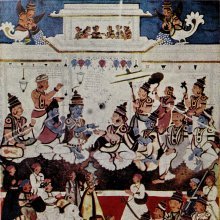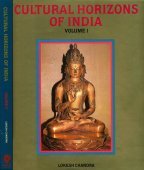Mural, Muraḷ, Muṟāl, Mūral: 2 definitions
Introduction:
Mural means something in biology, Tamil. If you want to know the exact meaning, history, etymology or English translation of this term then check out the descriptions on this page. Add your comment or reference to a book if you want to contribute to this summary article.
Images (photo gallery)
(+4 more images available)
Biology (plants and animals)
Source: Google Books: CRC World Dictionary (Regional names)1) Mural in India is the name of a plant defined with Buchanania lanzan in various botanical sources. This page contains potential references in Ayurveda, modern medicine, and other folk traditions or local practices It has the synonym Buchanania latifolia Roxb..
2) Mural is also identified with Buchanania latifolia.
Example references for further research on medicinal uses or toxicity (see latin names for full list):
· Hortus Bengalensis, or ‘a Catalogue of the Plants Growing in the Hounourable East India Company's Botanical Garden at Calcutta’ (1814)
· Journal of Cytology and Genetics (1990)
· Indian Journal of Pharmaceutical Sciences (1978)
· Quarterly Journal of the Mythic Society (1963)
· Journal of Tree Sciences (1984)
· Taxon (1979)
If you are looking for specific details regarding Mural, for example extract dosage, side effects, pregnancy safety, health benefits, chemical composition, diet and recipes, have a look at these references.

This sections includes definitions from the five kingdoms of living things: Animals, Plants, Fungi, Protists and Monera. It will include both the official binomial nomenclature (scientific names usually in Latin) as well as regional spellings and variants.
Languages of India and abroad
Tamil dictionary
Source: DDSA: University of Madras: Tamil LexiconMural (முரல்) [mural(lu)tal] 3 verb cf. murala. [K. moraḷ.] intransitive
1. To make sound; ஒலித் தல். மதுகரமுரலுந் தாரோயை [olith thal. mathugaramuralun tharoyai] (திருவாசகம் [thiruvasagam] 5, 16).
2. To cry; கதறுதல். குடுமிக் கூகை குராலொடு முரல [katharuthal. kudumig kugai kuralodu murala] (பத்துப்பாட்டு: மதுரைக்காஞ்சி [pathuppattu: mathuraikkanchi] 170). — transitive To sing; பாடுதல். ஏழ்புண ரின்னிசை முரல்பவர்க்கல்லதை [paduthal. ezhpuna rinnisai muralpavarkkallathai] (கலித்தொகை [kalithogai] 9).
--- OR ---
Mural (முரல்) noun < murala. Needle-fish, Syngnathus; மீன்வகை. [minvagai.] (நாமதீபநிகண்டு [namathipanigandu] 271.)
--- OR ---
Muraḷ (முரள்) noun probably from முரல். [mural.] A shell-fish; இப்பிவகை. [ippivagai.] (தொல். பொ. [thol. po.] 584.)
--- OR ---
Muṟāl (முறால்) noun A sea-fish; கடல்மீன்வகை. [kadalminvagai.] (J.)
--- OR ---
Mūral (மூரல்) noun [Telugu: muriyu, murugu, K. muruva, M. mural, Travancore usage murija.]
1. Tooth; பல். (பிங்கலகண்டு) [pal. (pingalagandu)]
2. Smiling; புன்சிரிப்பு. (பிங்கலகண்டு) முத்தவா ணகையின் மூரன் முகத்தியர் [punsirippu. (pingalagandu) muthava nagaiyin muran mugathiyar] (கம்பராமாயணம் களியாட்டு. [kambaramayanam kaliyattu.] 20).
3. Boiled rice; சோறு. பசுந் தினை மூரல் பாலொடும் பெறுகுவிர் [soru. pasun thinai mural palodum peruguvir] (பத்துப்பாட்டு: பெரும்பாணாற்றுப்படை [pathuppattu: perumbanarruppadai] 168).
4. Milk; பால். (பரிபாசை அகராதி) [pal. (paripasai agarathi)]
Tamil is an ancient language of India from the Dravidian family spoken by roughly 250 million people mainly in southern India and Sri Lanka.
See also (Relevant definitions)
Starts with: Mural pocha, Murala, Muralaccippi, Muralal, Murali, Murali-bamsa, Murali-makai, Muralidhara, Muralidharadasa, Muraligana, Muralika, Muraliprakasha, Muralitaran, Muralkalu, Muralkanci, Muralvu.
Ends with: Celumural, Karumural, Koluttamural, Kulumural, Kumural, Pacimural, Punmural.
Full-text (+18): Shilpashastra, Bhitti, Mural pocha, Malakamma, Punmural, Murakkattalai, Kulumural, Muralaccippi, Virupaksha, Karumural, Sittanavasal, Koluttamural, Varadaraja, Celumural, Virabhadra, Ranganathaswamy, Muralvu, Pacimural, Stiracittiram, Badami.
Relevant text
Search found 21 books and stories containing Mural, Muraḷ, Muṟāl, Mūral, Muraal, Mooral; (plurals include: Murals, Muraḷs, Muṟāls, Mūrals, Muraals, Moorals). You can also click to the full overview containing English textual excerpts. Below are direct links for the most relevant articles:
Dasarupaka (critical study) (by Anuru Ranjan Mishra)
Part 12 - Society in the Līlāvatī-Vīthī < [Chapter 7 - Vīthī (critical study)]
Hindu Pluralism (by Elaine M. Fisher)
The Tiruviḷaiyāṭal Purāṇam in Seventeenth-century Madurai < [Chapter 4 - The Language Games of Śiva]
Language Games of Śiva (Introduction) < [Chapter 4 - The Language Games of Śiva]
The Making of a Hindu Sectarian Community < [Conclusion—A Prehistory of Hindu Pluralism]
Samarangana-sutradhara (Summary) (by D. N. Shukla)
Folk-Art in India < [April – June, July – September 1978]
Folk-Art in India < [January, 1928]
Indian Art in London < [November-December 1934]
Tiruvaymoli (Thiruvaimozhi): English translation (by S. Satyamurthi Ayyangar)
Pasuram 3.9.1 < [Section 9 - Ninth Tiruvaymoli (Connal Virotam)]
Maha Prajnaparamita Sastra (by Gelongma Karma Migme Chödrön)
Appendix 3 - The usual light (prakṛtiprabhā) of the Buddha < [Chapter XIV - Emission of rays]
Jātaka of the red fish < [Part 2 - Hearing the twelve-membered speech of the Buddha]
Part 4 - The buddha’s frequent sojourns in Rājagṛha and Śrāvastī < [Chapter V - Rājagṛha]
Related products







